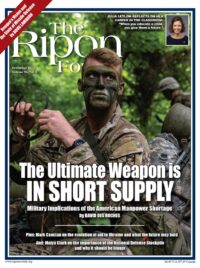 The National Defense Stockpile is a little-known and less-than-glamorous responsibility of the Defense Department. However, this reserve of raw critical materials plays an outsized role in U.S. national defense — and it needs help from Congress to continue playing this role.
The National Defense Stockpile is a little-known and less-than-glamorous responsibility of the Defense Department. However, this reserve of raw critical materials plays an outsized role in U.S. national defense — and it needs help from Congress to continue playing this role.
The Pentagon stockpiles 42 different raw materials — items like rare earth elements and carbon fibers — needed to manufacture essential defense items, everything from ships and planes to ammunition. These stores constitute an important insurance policy against supply chain disruptions that could inhibit access to these materials.
The stockpile was first created in 1939, when policymakers could see that World War II would interrupt supplies of rubber, steel materials, and other materials that would be vital to the U.S. war machine, and later, the U.S. war effort.
The stockpile only grew during the Cold War — from a total value of $54 million in 1941, to a total value of $4 billion by 1952. The stores in the stockpile reached peak total value in 1989, when they were assessed at $9.6 billion.
But when the Cold War ended, the stockpile was no longer seen as a priority. Most of its contents were sold off, and those funds reallocated to more pressing needs. Today, the stockpile is but a fraction of its former self; its cache of materials is valued at less than $1 billion. Corrected for inflation, that’s less than 1/40th of its value in 1952.
Today, the stockpile is but a fraction of its former self; its cache of materials is valued at less than $1 billion. Corrected for inflation, that’s less than 1/40th of its value in 1952.
Unfortunately, the United States is not 40 times less likely today to experience disruption to its supplies of key materials than it was 70 years ago. Nor does it exist in a global environment 40 times safer than that of the Cold War era.
Instead, the U.S. is once again engaged in great-power competition, and once again it needs a robust National Defense Stockpile to guard against supply disruptions.
Indeed, the stockpile is all the more important today because, in many cases, the primary supplier of the raw materials it contains is also America’s chief global competitor: China.
Take antimony for an example. This semi-metal is used to manufacture automotive batteries, flame-retardant fabrics, some explosives, and night-vision goggles. It is also primarily produced in China, which accounts for 55 percent of global antimony mine production and fully 63 percent of U.S. antimony imports.
If China ever wanted to put pressure on the U.S. defense industry, it could restrict its exports of antimony, rare earth elements, lithium, or any number of other vital materials of which it is the leading global producer. This could drastically raise the costs of U.S. defense production or halt that production altogether.
The stockpile is all the more important today because, in many cases, the primary supplier of the raw materials it contains is also America’s chief global competitor: China.
This is a massive national security risk. The good news is, the National Defense Stockpile serves to buy down that risk. But it can only accomplish that goal if it contains the right quantities of the right materials.
Congress should use its budgetary and oversight authorities to make sure the stockpile is meeting these requirements. To ensure that it contains the materials most vital to defense production, the House and Senate Armed Services Committees should require the Pentagon to contract with a third party to independently review the stockpile’s holdings and its practices. Lawmakers already have the legal authority to request this information from the Defense Department; Congress just needs to use it.
The National Defense Stockpile may or may not contain exactly the right materials. But it is undeniable that, with a total value of less than $1 billion, it does not contain enough of those materials. Congress should provide a financial “transfusion” of appropriated funds to the stockpile.
The good news is that both the House and Senate versions of the National Defense Authorization Act contain provisions related to the stockpile. The Senate version specifically authorized $1 billion for the stockpile to acquire strategic minerals currently in short supply. If this provision is enacted in the final legislation, it will more than double the size of the stockpile.
It is easy to forget about the National Defense Stockpile. After all, it represents only a tiny fraction of defense spending. And, like any emergency measure, it for the most part sits unused. However, it is vitally important in the new era of great-power competition and globalized supply chains. Congress and the Pentagon should prioritize it accordingly.
Maiya Clark is a senior research associate in The Heritage Foundation’s Center for National Defense.




